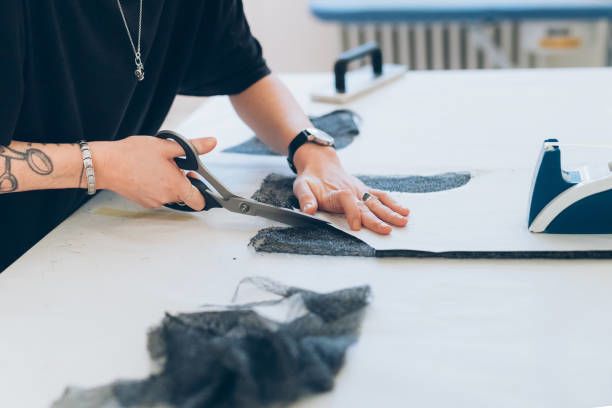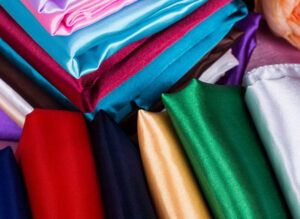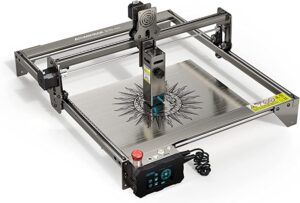If you are into sewing, you may know how hard is it to cut fabric straight. Isn’t it frustrating to finish sewing something to see it twisted?
One of the most important things, then, is to figure out how to do it correctly. Obviously, using quality tools is a crucial part of the process, but that’s not all.
There are many different types of fabric, and most of them have their own tricks. It’s not the same to cut silk than leather, so you will have to be very skilled and patient.

But don’t worry: in this article, you will find tips and advice on how to cut fabric straight, how to choose the perfect tools, and even methods to carry out this activity smoothly.
Why is this procedure so difficult?
Because there are many factors that affect the cutting. The first one of them is the type of fabric. Also, the quality and type of tool that you use, and the method you follow will determine if the line that you decide to cut is finally straight or not.
Let’s take a look at some tips below to see how to do it properly, without ripping the fabric apart or ruining your soon-to-be quilt.
Differences between different types of fabric
Woven fabric has a pattern made up of a great number of threads. This type of thread does not usually stretch unless they have elastane components specifically.
Another type of fabric includes the knit one, which was looped by a professional using continuous thread interlocked. Again, it does not stretch very much.
Finally, there are fabrics that have not been woven at all, like felt. They have been put together in a mechanical, chemical, or thermal way. The fibers are separated. As all of them are very different in nature, the way of cutting them will differ as well.
Cutting tips for varied fabric types
- Plain fabric. The most difficult thing with plain fabric is that both sides look almost the same. You will have to make sure the face of the thread is upside before starting to cut. One tip to distinguish the face from the back is to look for the smoother side.
- Leather. The rotary cutter is the best method for cutting this type of fabric. Scissors are not a good idea, as the fabric will surely tear apart.
- Chiffon. This is a very slippery type of fabric, not easy to cut at all. Some people will tell you to get it, as it will give it some weight, but it almost certainly will not result in a flawless cut, so the best idea is to use scissors instead of a rotary cutter.
- Delicate fabrics. This is a type of thin fabric, so the idea is to cut it together with paper that will help you not to ruin it. One example of this is silk.
Some things you should not forget before cutting
Wash and Iron
Washing the fabric after acquiring it is a great idea because it tends to shrink at least a little bit. Of course, you should also dry it before starting with a project.
Ironing is the last step to eliminate wrinkles and make the fabric flat.


Use a Flat Surface to Cut
Using a flat surface is crucial, and it is also important for it to be hard. Forget about the floor or your bed.
When using a table, all the edges should be up there as well. Make sure nothing hangs, because if not, you might trip on it and cause uneven lines.
Fabric cutting tables might come in handy on these occasions as well. These are specially designed to make the process easier while taking care of your posture.
Any person who sews knows how important that is, in particular, if you spend long hours doing this. Some of these fabric cutting tables even include drawers for more comfort.
Choose the Perfect Scissors
This tool will make a lot of difference when cutting. If you have a high-quality one, the process will be smooth. Of course, they are not cheap.
Cheaper scissors usually get dull in a short period of time, or its blade gets ruined. They are not very durable, so it’s better to invest a little bit more for quality tools.
Some tips to choose the perfect ones include:
- Consider the size of the tool. If it’s too big or too small for your hand, it will be hard for you to manipulate it, therefore to cut straight.
- Make sure you can sharpen it. All scissors get dull at some point, and if you cannot sharpen them, then you will have lost your money.
Look for the Perfect Edge
The straight edge is the first thing you should look for when trying to cut fabric (it is also called the selvage line). That will be your starting point.
Helpful Tools and How to Choose them
Rotary Cutter
A rotary cutter looks like a pizza one, and it’s a very helpful tool when it comes to cutting fabric.
It comes in different sizes, so you will need to get familiar with them and choose accordingly. Some of them are 45mm, others 60 mm.
They are usually very sharp, so you need to be extra careful when using these blades. The retractable models come in very handy, so consider acquiring one even if they are a bit expensive.


Also, a cutting mat becomes essential. If you don’t use a quality one, you’ll end up ruining the table or whatever surface you are cutting in.
One of the advantages of using a big rotary blade includes being able to cut through many layers, which is not that simple when using scissors. Smaller ones will be suitable for working with small or curved pieces.
Acrylic Rulers
Also called quilting rulers, these items will allow you to cut in a very precise way. Most of them are retractable, meaning that you’ll be able to manipulate it very easily, no matter the angle in which you are cutting.
In addition, try to go for one that folds. It will help when working with all the sides. The measurements are usually easy to read, and most models include a non-slip feature to prevent the ruler from falling off your hands.
Scissors
Again, these are essential when it comes down to cutting. There are mainly two types. One of them is bent handled scissors, that will allow you to cut in a more comfortable way.
However, if you wish to protect your fabric from tearing, maybe you should decide on blunt-point tools that are a little bit more uncomfortable but safer.
Cutting Mat
A fabric cutting mat is a must when it comes to cutting and not ruining the surface of your table, for example.
Did you know that there are self-healing fabric cutting mats?
These are made with a grid so that you can clearly see what you are doing. There are hundreds of types in the market, that go from huge ones to very small ones that will be useful when it comes to quilting pieces.
Fabric Cutting Machines
These are devices designed to cut fabric (even in multiple layers!) in a quick and precise manner, just by pressing a button. They are incredibly useful when quilting because they are way more accurate when cutting than any other method.
Even though fabric cutting machines are not cheap, they can be a great investment, especially if you dedicate yourself to quilting.
Methods to Cut Fabric
Cut by Pulling a Thread
This is one of the easiest methods to cut any type of fabric in a flawless manner, especially the woven type. Some of its advantages are:
- It’s very simple to do, you won’t need a lot of tools
- It’s precise, so don’t worry about ruining the thread
So, the first thing you have to do is to look for an unfinished part of the fabric, and then separate just one edge to pull it from the thread.
Make sure you strengthen the cloth again to eliminate possible wrinkles. Then, use the gap that this generated as a guideline to cut.
It’s crucial to hold the cloth with one hand as you hold the scissors with the other to make sure you don’t break the whole thing.
Never take the fabric away from the table until you have finished with the process.


Cut by Using a Grainline
For this to happen in a precise and smooth way, you will need good rulers.
One with a straight angle would be a perfect choice. In this way, the ruler will be in line with the selvage and it’s easier to measure the line in which you will want to cut.
- Take the ruler with a firm grasp. Don’t move it! Draw a line with a pencil or marker.
- Just use your very sharp scissors to cut along the line! Again, you will need a very firm grasp or you may end up in disaster.
- You may consider that if the fabric is woven, then it will have a grainline that is very useful when cutting using this method.
Cut by Ripping the Fabric
This is one of the most traditional methods ever used. You may see shop assistants rip the fabric and wonder how they do it so precisely.
The first thing you need to know is that this is not possible for any type of cloth: you can only do this when the fabric has been woven, like cotton, silk and so on.
On top of that, it has to be a quality product. If it has elastane threads, then it won’t work. Some useful advice:
- Don’t follow the grainlines. It’s much better to do it following the lines that go in a perpendicular direction to the selvages of the piece.
- The process is very simple: start cutting using scissors some cm away from the edge. Then, you just have to full the fabric apart firmly and quickly.
Conclusion
This activity is certainly challenging. There are a lot of myths about how to cut fabric straight. From the type of cloth to the right scissors, there are a lot of details to consider.
With the above tips, however, forget about your clothes or quilts being twisted or flawed. Using the right tools is important, of course. But having the right attitude and following expert advice gets flawless results.





